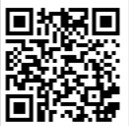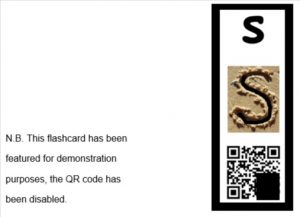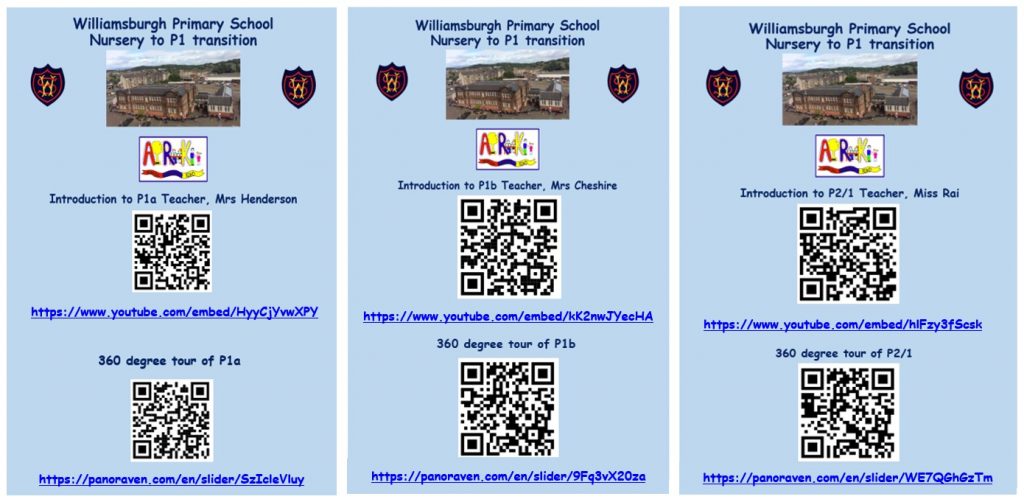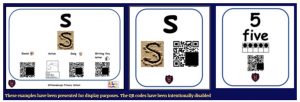By Aileen Mackey
Abstract
In response to safety measures to protect the public during the Covid-19 pandemic, children and families were required to adapt to several transitions within the education sector. These include transitioning to and from remote learning and between establishments. This challenged education staff to maintain their responsive support, and pupil’s engagement in their learning and play provision. Through observations and staff collaboration with children and families in Nursery and Primary 1 (P1), transitional challenges were identified together with children’s skills, interests and abilities to be proactive autonomous agents. This was key to developing a new digital strategy using Quick Response (QR) codes. These were linked to tailor made videos, drone footage and school blog, which responded to child and families interests, needs and queries. QR codes were also used as a tool for constructing sustainable resources for learning and play, education recovery and an innovative method for staff digital training. This digital strategy was highly evaluated, overcame several barriers to equity, promoted inclusion, achieved engagement in service provision, and supported children to be resilient skilful learners. This enabled continuity of pedagogical approaches and service provision on a remote basis, catalysing positive transitional experiences.
Children, families and staff within the education sector have been faced with unprecedented challenges during the Covid-19 pandemic, particularly in relation to maintaining engagement in learning and play, providing responsive support, and planning for positive transitions (e.g. to and from remote and hub learning, and between establishments). Research conducted by UNESCO (2021) and the Scottish Government (2020) uncovered the pandemic has intensified previous educational inequities, such as the poverty attainment gap, finances, health and wellbeing, families balancing learning support between siblings, work commitments and available technology. School closures, restricted numbers of public gatherings and social distancing has resulted in an increased reliance on digital technology (Scottish Government, 2021). Upholding health and safety measures to protect the public, required education staff to use unconventional methods to encourage and support child and family engagement, and understand influential factors in transitions.
Transitions are a process of changes from one context to another rather than a singular event, and have a significant impact on children’s lives (Education Scotland, 2020). Planning for positive transitions must therefore take into consideration influential factors. Bronfenbrenner‘s (1979) Ecological system’s theory highlights the importance of ‘contextual systems’, i.e. the interplay between environmental changes and an individual’s subjective perception of the change process (Eriksson, Ghazinour and Hammarstrom, 2018; Stokols, 1996). The Multiple and Multi-dimensional Transitions (MMT) theory (Jindal-Snape, 2016) provides a greater insight, explaining the complex, simultaneous and multiple changes that occur during the process of transitions. These changes include environmental, relationships and the perception of change by the individual and those associated with them (Jindal-Snape, 2016). Understanding this highlights the level of demand on individuals to adapt, differences in subjective experiences, and the need to provide responsive support and plan for positive transitions. Reinforcing the above, research from ‘The Scottish Transitions as a Tool for Change Project Group’ (2019) identified factors which encourage positive transitions. These include; consistent collaboration and empowerment of all involved in the transition process, holding positive opinions about the change process and environment, feeling safe, valued, respected, self-belief in ability to cope, and the experience meeting or exceeding expectations (The Scottish Transitions as a Tool for Change Project Group, 2019).
Resilience is an individual’s ability to manage change, influenced by past experiences, perceptions, coping strategies and available support (Mentally Healthy Schools, 2020). Risk factors include; low socioeconomic status, additional needs, poor wellbeing and those who have English as an Additional Language in English speaking societies (Bailey and Bains, 2012; West, Sweeting and Young, 2008; Education Scotland, 2020; Scottish Government, 2012). It is important for children to develop transitional resilience and positive experiences of change, in order to explore their interests, creativity, and develop skills to reach their full potential. Resilience thus impacts upon children’s wellbeing and educational outcomes (Education Scotland, 2020; Brooker, 2008; OECD, 2017; Newman and Blackburn, 2002). To support the development of children’s transitional resilience, it therefore necessary for education staff to observe and collaborate between themselves, pupils and their families (Dockett and Perry, 2007; 2020). This will enable identification of those involved in a transition, factors which improve and impede this process, predicted impact, the diversity that exists within groups and children’s current transitional resilience. This equips staff with the knowledge of children’s ‘Zone of Proximal Development’ (Vygotsky, 1978), and how they can work in partnership with families to scaffold children’s skills to achieve positive transitional experiences.
My position as Early Learning and Childcare Officer is financed through ‘Pupil Equity Funding’, to accomplish “equity in educational outcomes” for children, and “close the poverty related attainment gap” (National Improvement Hub, 2021, p.1). Pedagogical approaches, collaboration, Shared Sustained Thinking (Siraj and Asani, 2015), sharp observation skills, responsive practice and family engagement are fundamental within in my role. The rapidly changing context of the Covid-19 pandemic resulted in Nursery, P1 children and families experiencing several significant transitions (e.g. remote learning and from Nursery to School). This was further compounded by these children and families limited experience within the education system. It was therefore necessary to develop a collaborative, solutions focused, creative and responsive approach to achieve positive transitions, and to maintain pupil’s engagement in our service provision.
I reflected upon the digital age in which we currently live, children’s present digital skill base, and their preference for using technology. I aspired to devise a sustainable digital strategy which responded to needs, interests and challenges, promoted positive transitions, engagement in our provision, digital literacy across the curriculum, attainment, wellbeing, independence and inclusion. I also strived for this strategy to be in line with the United Nations Sustainable Development Goal 4, ‘Quality Education’ (United Nations, 2021). I referred to the Digital Learning and Teaching Strategy for Scotland (Scottish Government, 2016) in order to inform my planning:

Scottish Government, 2016, p.13.

Scottish Government, 2016, p.24
My observations of young children’s engagement with iPad devices in Nursery and School was that they were predominately used for taking pictures, videos, and using apps downloaded by education staff. I perceived that QR codes linked to responsive YouTube videos could be used as a sustainable strategy for provoking learning and play across the curriculum and positive transitions. This strategy would reflect children’s interests, scaffold their existing digital skill base, and empower them as proactive and autonomous agents within their learning and play environment, enhancing my pedagogical approach. I could foresee that QR codes could also be used for the purpose of inclusion, overcoming written communication and interpretation barriers (for children learning to read, those who have additional needs or English as an Additional Language), heighten engagement (due to ease of access), revision, evaluation, homework, remote learning, focus groups, displays and vertical learning between stages (which could be conducted socially distanced).
To trial this strategy, P1 Digital leaders learned how to select and scan QR codes with iPads, based on their preference. Their role was to scaffold peers learning regarding this activity. Children had made a dinosaur museum based on their interest, and this featured QR codes linked to related videos (I filmed and selected). An associated picture was displayed next to the QR code, to explain the content of the video, enabling choice, and provoking further learning and play. The following embedded video showcases the popularity of this activity, how quickly children achieved this digital skill, and their enjoyment leading learning:

https://www.youtube.com/embed/2P6SXDwSRAY
Through collaboration, I supported children to make health and wellbeing and School values animations, which featured their comments. These were linked to QR codes to enable us to create interactive displays, showcase children’s learning, and provide opportunities for vertical learning between stages:

I predicted school closures would occur in the imminent future, due to the rapid increase in Covid-19 cases locally and nationally towards the end of 2020. In response, to further scaffold children’s learning, I constructed a QR code phonics education package, containing flashcards for P1 children to take home. Each card featured a letter, associated real-life picture, and a QR code, which was linked to a video of a phonics song.

The format of these flashcards removed written communication and interpretation barriers, enabled children to independently scan, understand, learn and revise phonics themselves and with families, thereby promoting a play based approach to learning and wellbeing, relating to the 4 capacities of ‘Getting It Right For Every Child’; Successful learners, Confident individuals, Responsible citizens and Effective contributors (Scottish Government, 2021b).
Due to the success of the above education package, when school closures were confirmed in January 2021, I constructed a further education package for P1 and Primary 2 (P2) children, containing phonics and digraph flashcards. Management and support staff enquired and ensured all targeted families had access to our learning provision through digital devices during school closures. To promote a positive transition to remote learning in P1 and 2 and encourage child and family engagement through ease of access, I constructed a remote learning access letter. This featured a QR code which was linked to our school blog (where our remote learning provision resided). Our School values the relationships we have with children and families, and the quality of our service provision. For this reason, I conducted wellbeing telephone calls each week to P1 and 2 families. During these calls I discussed family wellbeing, children’s engagement with remote learning, related challenges, enjoyment, pace of learning, current interests, and ensured families were supported responsively.
Feedback regarding the use of QR codes was very positive. However, on the first week, families reported that children missed seeing staff, it was a challenge encouraging children to do as instructed from the activities written on the blog, finding time to read the blog, and balancing learning, wellbeing support, devices and work commitments between siblings. These challenges were heightened among families who had English as an Additional Language. This feedback was discussed with our Management and Teaching team. I suggested we switch from written content to making responsive YouTube videos (featured on our blog), reflecting child and family weekly feedback, the curriculum, and children’s stage of development. This was agreed, and we incorporated the QR code flashcards into our video lessons to promote their use. In response to the above collaborative measures, we overcame the challenges raised, which resulted in enhanced engagement in our provision, and we received excellent feedback and evaluations (from children, families and senior stakeholders). This method of service delivery:
- Maintained our pedagogical approach
- Enabled us to demonstrate role play with everyday resources
- Provided opportunities for children to respond to us, as we left pauses in our video’s.
- Responded to children’s interests, challenges and pace of learning
- Enhanced children’s engagement with our learning and play provision across the curriculum
- Improved children’s digital literacy across the curriculum
- Overcame written communication barriers
- Heightened children’s ability to be proactive autonomous agents (by scanning the QR codes and accessing the embedded videos on our blog)
- Enabled families to balance learning support between siblings and work commitments, at a time convenient to them.
- Developed children’s resilience for learning and play
- Achieved a smooth positive transition for children back to school as we provided continuity of our learning and play approach throughout school closures, and responded to children and families need and interests throughout this process.
Our remote learning provision and associated digital strategy was showcased within West Partnership (2021) and Education Scotland’s DigiLearn websites (Mackey, 2021a; 2021b) as an example of good practice within the education sector. Practical examples of our remote learning provision and the techniques we used to engage children, can be viewed in the following chaptered video montage:

https://www.youtube.com/embed/_W5FrTv0M3U
To support children’s education recovery on their transition back to school (using their existing skills), I linked all of our P1 and 2 remote learning videos to QR codes, and featured these within curricular worksheets. These also contained a picture (to inform about the required resources, lesson content and to overcome written communication barriers), and a learning support graphic, e.g. number line. These worksheets can now be used sustainably to close gaps in learning, revision, homework, focus groups, displays and supporting children with additional needs. Examples of these are as follows:

In order to scaffold children’s learning and skills further, I linked videos of their learning, play and discussions to QR codes, which were displayed on friezes. This also provided opportunities for vertical learning, revision and evaluation. An example of this can be viewed as follows:

Towards the end of the academic year 2020/2021, education staff, Nursery children and families were challenged with transitioning to School under Covid-19 safety measures. This resulted in families being unable to accompany children within our School during visits, large groups of children being prevented from visiting the school, and staff were required to maintain social distancing and wear face masks. Sink, Edwards and Weir (2007, p.233) highlight the transition from Nursery to School is a “critical period for young children’s social and academic development”, emphasising the importance of this being a positive experience. Our staff’s knowledge and experience of best practice regarding transitions informed our planning. Alison Vandal (our School Deputy Head Teacher) collaborated with families through emails, Google meets, forms and Teams to discuss transitional queries, ascertain children’s needs, skills, interests, coping methods, and perceptions of the transition process. Nursery staff also collaborated with children regarding their queries about transitioning to School. This information was shared with school staff, and in response, we made a fleet of transition videos with School pupils. Drone footage of our P1 classrooms and Open area was filmed by our Primary 5 Teacher, John McMaster. This enhanced our remote pedagogical approach, by enabling children and families to explore these areas as frequently as desired, at their pace, and which reflected their interests. Following our previous success (and for the aforementioned reasons), I linked QR codes to these videos, which were chaptered and embedded for ease of reference and digital safety. These QR codes were included in transition letters to children, families and Nursery staff, to inform, familiarise, promote inclusion, reduce anxieties, encourage engagement through ease of access, and introduce our digital strategy. Examples of our Nursery- P1 transition letters are as follows:


Collaboration with children and families, our interactive resources, and responsive videos, received excellent feedback. As a result, children and families developed positive perceptions about our service provision, and were well informed and familiar with our staff and practice prior to children’s first visit to School. This was a very positive experience, which built on children’s knowledge of our School, and enabled staff to discuss children’s interests, and the resources we would responsively source for them starting school (supporting the transition process further). Our methods to promote positive transitions incorporated theoretical perspectives (previously discussed), collaborative evidence, recommendations for best practice, creativity, responsive support and promoted children’s skill development for transitions and digital literacy.
Due to the success and impact of using QR codes during transitions in 2020-2021, this strategy has been included in our School Improvement Plan. I have constructed a new QR code educational package and a Virtual classroom for homework for the academic session 2021/2022. This is sustainable, more inclusive, and will develop the digital literacy skills Nursery children achieved during their transition to School further (Mackey, 2021c). This includes:

- QR code Phonics worksheets which include a sound, action, song and how to write this letter, together with a related Picture Exchange Communication graphic to heighten children’s understanding of each task. These resources will support children who are learning to read, write and revise. These resources also benefit those who have English as an Additional Language and children with additional learning needs.
- QR code Phonics flash cards/ display provocations.
- QR code Number flash cards/ display provocations.
- QR code linked to a ‘Thinglink’ Virtual classroom for homework, which is adapted on a weekly basis in response to engagement statistics, children’s interests expressed in School and their stage of development. Audio prompts and video footage linked to each tag enhances children’s ability to independently engage with and understand learning activities (overcoming written communication barriers). Numbered tags also encourage recognition and sequencing.

I have also devised a new sustainable method for delivering staff digital training which incorporates QR codes. This removes the need for staff to take notes and training notes to be printed, and provides an efficient method for staff to revise content and refer to in future. My digital training has received excellent feedback from staff, and has expanded opportunities to improve children’s outcomes throughout our School in relation to future transitions and learning.
To conclude, QR codes are an excellent tool for enhancing service delivery, promoting inclusion, independence, encouraging engagement in learning and play, and supporting transitions within the education sector. The versatility of QR codes enables them to be sustainably used for a variety of purposes. These include interactive resources and provocative displays (for learning across the curriculum, play, vertical learning between stages, revision and evaluation), education recovery, digital skill development, training, opportunities for children to lead learning during play, and sharing videos which respond to children and family’s needs and queries during transitions. Linking QR codes to responsive videos heightens engagement in service provision, and overcomes written communication barriers, thus promoting inclusion. This provides opportunities for staff to build children and families resilience to learning in different contexts, and transitioning between establishments. This strategy enables continuity of staff pedagogical approaches and support, catalysing positive transitional experiences, to improve children’s outcomes. Adoption of this sustainable strategy into practice is therefore recommended on a wider basis within the education sector.
Aileen Mackey BSc (HONS), BSc. is an Early Learning and Childcare Officer at Williamsburgh Primary School in Renfrewshire, Scotland. She is passionate about pedagogy, transitions, parental engagement, digital literacy, STEM, closing the attainment gap and promoting creativity and equity. She has a BSc (Hons) in Psychology, BSc in Mental Health Nursing, and is in her final year studying BA Childhood Practice at the University of Dundee, UK. Aileen is a member of TCELT’s International Network of Transitions Researchers.